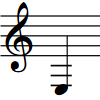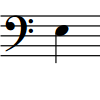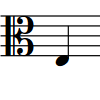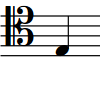Clefs
Clefs are the symbol at the start of every system that give the notes on the staff context; that is, the clef tells you which note of the scale applies to each line or space of the staff.
For example, the treble clef is also known as a “G clef”, because the spiral shape in the middle centers around G, normally the one above middle C.

The other common clefs are:
-
The bass clef, or F clef, in which two dots are shown either side of the line corresponding to F, normally the F below middle C.
Middle C uses one ledger line below staves with treble clefs, and one ledger line above staves with bass clefs.
-
The C clef, in which the center of the bracket to the right of the clef’s thick vertical line is positioned on the line that corresponds to C, normally middle C.
The C clef today is commonly used at two positions on the staff:
-
On the middle line of the staff, commonly called the alto clef.
-
On the line above the middle line of the staff, commonly called the tenor clef.
To minimize the number of ledger lines required, these clefs are used to match the register of the instrument for which they are used.

|

|

|

|
In Dorico Pro, clefs and octave lines are both contained in the Clefs panel on the right of the window. Three sections of the panel apply to clefs:
-
Common Clefs, including treble clef, bass clef, alto clef, tenor clef, tab, and percussion.
-
Uncommon Clefs, including Indian drum clef, French violin clef, treble clef octave above, treble clef octave below, and so on.
-
Archaic Clefs, including baritone bass clef, mezzo-soprano clef, and soprano clef, which are not commonly used any more.